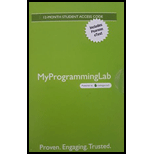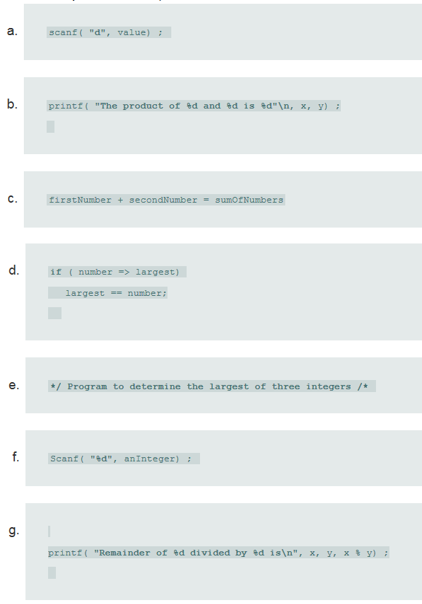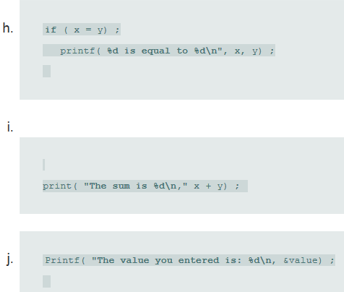
Identify and correct the errors in each of the following statements. (Note: There may be more than one error per statement.)

(a)
To identify and correct the error in the following statement.
scanf(“%d”, value);
Explanation of Solution
Given information:
scanf(“d”, value);
Explanation:
Format specifier missing %d is used to take integer type value from the user. Missing percentage symbol % to be placed before the format specifier d.
Correct statement:
scanf(“%d”, value);
(b)
To identify and correct the error in the following statement.
printf(“The product of %d and %d is %d\n”,x,y);
Explanation of Solution
Given information:
printf(“The product of %d and %d is %d”\n,x,y);
Explanation:
The \n is escape sequence used to assign a new line. All the escape sequences used inside the double quotes (“”) of printf statement. Here, the escape sequence is out of the double quotes area. To correct this statement, make \n inside the double quotes area.
Correct statement:
printf(“The product of %d and %d is %d\n”,x,y);
(c)
To identify and correct the error in the following statement.
sumOfNumbers=firstNumber + secondNumber;
Explanation of Solution
Given information:
firstNumber + secondNumber = sumOfNumbers
Explanation:
The associativity of equals to (=) operator is right to left so that it will first calculate firstNumber + secondNumber, then assign this value in sumOfNumbers. Also, semicolon (;) missing at the end of the statement.
Correct statement:
sumOfNumbers = firstNumber + secondNumber;
(d)
To identify and correct the error in the following statement.
if(number >= largest)
largest=number;
Explanation of Solution
Given information:
if(number => largest)
largest==number;
Explanation:
The operator Greater then or equals to having a wrong syntax (=>), correct syntax should be (>=). Comparison operator is used instead of the assignment operator (=).
Correct statement:
if(number >= largest)
largest=number;
(e)
To identify and correct the error in the following statement.
/* Program to determine the largest of the integer */
Explanation of Solution
Given information:
*/ Program to determine the largest of the integer /*
Explanation:
Wrong syntax of multiline comment, the correct syntax should be: -
/* some-comment */
Correct statement:
/* Program to determine the largest of the integer */
(f)
To identify and correct the error in the following statement.
scanf(“%d”, &anInteger);
Explanation of Solution
Given information:
Scanf(“%d”, anInteger);
Explanation:
The initial of Scanf keyword should be lowercase. The ampers and (&) required before anInteger.
Correct statement:
scanf(“%d”, &anInteger);
(g)
To identify and correct the error in the following statement.
printf(“Remainder of %d division by %d is %d\n”, x, y, x%y);
Explanation of Solution
Given information:
printf(“Remainder of %d division by %d is\n”, x, y, x%y);
Explanation:
Format %dspecifier needed to print the value of x%y.
Correct statement:
printf(“Remainder of %d division by %d is %d\n”, x, y, x%y);
Want to see more full solutions like this?
Chapter 2 Solutions
MYPROGRAMMINGLAB WITH PEARSON ETEXT
Additional Engineering Textbook Solutions
Web Development and Design Foundations with HTML5 (8th Edition)
Starting Out with Java: From Control Structures through Data Structures (4th Edition) (What's New in Computer Science)
SURVEY OF OPERATING SYSTEMS
Computer Science: An Overview (13th Edition) (What's New in Computer Science)
Degarmo's Materials And Processes In Manufacturing
INTERNATIONAL EDITION---Engineering Mechanics: Statics, 14th edition (SI unit)
- Ensure you answer the question asked at the end of the document. Do not just paste things without the GNS3 console outputsarrow_forward"Do not use AI tools. Solve the problem by hand on paper only and upload a photo of your handwritten solution."arrow_forward"Do not use AI tools. Solve the problem by hand on paper only and upload a photo of your handwritten solution."arrow_forward
- "Do not use AI tools. Solve the problem by hand on paper only and upload a photo of your handwritten solution."arrow_forward"Do not use AI tools. Solve the problem by hand on paper only and upload a photo of your handwritten solution."arrow_forwardSolve this "Do not use AI tools. Solve the problem by hand on paper only and upload a photo of your handwritten solution."arrow_forward
- "Do not use AI tools. Solve the problem by hand on paper only and upload a photo of your handwritten solution."arrow_forward"Do not use AI tools. Solve the problem by hand on paper only and upload a photo of your handwritten solution."arrow_forwardSpecifications: Part-1Part-1: DescriptionIn this part of the lab you will build a single operation ALU. This ALU will implement a bitwise left rotation. Forthis lab assignment you are not allowed to use Digital's Arithmetic components.IF YOU ARE FOUND USING THEM, YOU WILL RECEIVE A ZERO FOR LAB2!The ALU you will be implementing consists of two 4-bit inputs (named inA and inB) and one 4-bit output (named out). Your ALU must rotate the bits in inA by the amount given by inB (i.e. 0-15).Part-1: User InterfaceYou are provided an interface file lab2_part1.dig; start Part-1 from this file.NOTE: You are not permitted to edit the content inside the dotted lines rectangle. Part-1: ExampleIn the figure above, the input values that we have selected to test are inA = {inA_3, inA_2, inA_1, inA_0} = {0, 1, 0,0} and inB = {inB_3, inB_2, inB_1, inB_0} = {0, 0, 1, 0}. Therefore, we must rotate the bus 0100 bitwise left by00102, or 2 in base 10, to get {0, 0, 0, 1}. Please note that a rotation left is…arrow_forward
 C++ Programming: From Problem Analysis to Program...Computer ScienceISBN:9781337102087Author:D. S. MalikPublisher:Cengage Learning
C++ Programming: From Problem Analysis to Program...Computer ScienceISBN:9781337102087Author:D. S. MalikPublisher:Cengage Learning C++ for Engineers and ScientistsComputer ScienceISBN:9781133187844Author:Bronson, Gary J.Publisher:Course Technology Ptr
C++ for Engineers and ScientistsComputer ScienceISBN:9781133187844Author:Bronson, Gary J.Publisher:Course Technology Ptr Microsoft Visual C#Computer ScienceISBN:9781337102100Author:Joyce, Farrell.Publisher:Cengage Learning,
Microsoft Visual C#Computer ScienceISBN:9781337102100Author:Joyce, Farrell.Publisher:Cengage Learning, EBK JAVA PROGRAMMINGComputer ScienceISBN:9781337671385Author:FARRELLPublisher:CENGAGE LEARNING - CONSIGNMENTNp Ms Office 365/Excel 2016 I NtermedComputer ScienceISBN:9781337508841Author:CareyPublisher:Cengage
EBK JAVA PROGRAMMINGComputer ScienceISBN:9781337671385Author:FARRELLPublisher:CENGAGE LEARNING - CONSIGNMENTNp Ms Office 365/Excel 2016 I NtermedComputer ScienceISBN:9781337508841Author:CareyPublisher:Cengage




